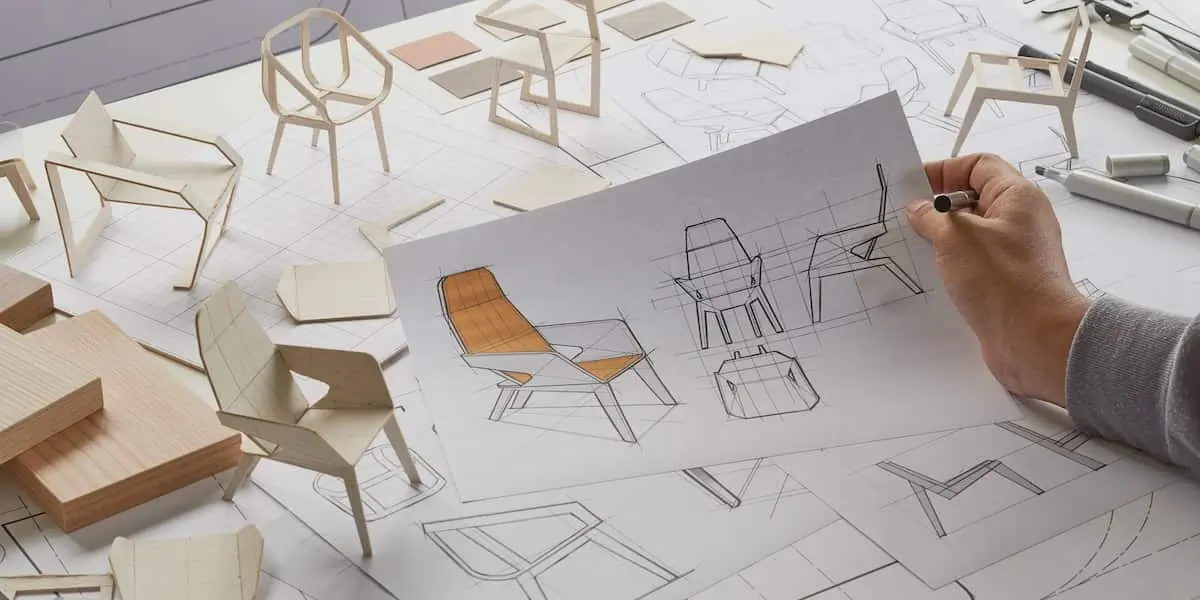Product design engineers design and build physical items that provide value to users by satisfying a need.
What are you using to read this article right now? A phone, tablet, or desktop computer? Are you drinking coffee from a mug or listening to music through headphones while you read? A product design engineer played a critical role in bringing all these everyday objects to market.
If you’re a naturally inquisitive problem solver who can’t help imagining how to improve even the most mundane everyday objects, a career as a product design engineer might be for you. Not only does it offer a chance to exercise your creativity and analytical inclinations, but it’ll also help you develop skills that will serve you well in a variety of roles during your lifetime.
So what do you need to know about becoming a product design engineer? Read on to find to find out:
- What does a product design engineer do?
- What’s the difference between a product design engineer and a product designer?
- Where do product design engineers work?
- How to become a product design engineer (Step-by-step guide)
- Final thoughts
- Product design engineer FAQ
1. What does a product design engineer do?
Product design engineers create physical objects that solve a specific problem. They use product requirements, market research, and specific computer-aided software (CAD) to design and bring them to market.
What are product requirements?
In order to build a product that comprehensively solves a problem, you need to define how your product will do this (features and functionality) and why this product is needed (purpose). Product requirements also can include specific characteristics like weight, size, color, materials, etc. All this information will form the foundation of your product requirements.
For example, maybe your client wants to build something that will enable users to transport and drink hot liquid, like coffee, on the go. In this case, a travel mug solves this particular problem.
Some basic product requirements for this travel mug might be:
- Small enough to fit in a cupholder in a car
- Dishwasher safe
- Able to keep hot liquids above 100 degrees for at least 30 minutes
What is market research?
One of the worst mistakes a product design engineer can make is creating a product that doesn’t deliver value. Perhaps it solves one problem but creates another, larger issue. Or maybe it is too confusing for people to use, so they never experience the full value.
Market research is the act of pressure-testing your concepts and products to validate your hypothesis that they will indeed solve the problem. You can do research by talking to people individually or use third-party information that will help you confirm your ideas.
What is computer-aided design software? (CAD)
Maybe the very first iteration of a new product is scrawled on the back of a napkin. But that won’t cut it once you need to build a prototype. CAD software enables product design engineers to create digital 2D drawings and 3D models that can be easily modified during the refinement stage.
Now that you know what product design engineers use to create products, let’s move on to daily tasks for product design engineers.
Product design engineer tasks
Product design engineers work on products from inception to overseeing the manufacturing process. Everything from dreaming up the initial concept to researching product costs to gathering customer feedback falls under their purview. Here are some of their regular tasks:
- Coming up with product ideas
- Crafting product requirements that align with the client’s budget
- Conducting market research to understand what other products exist and how to fill the gap in the market
- Drafting designs or models of the product using CAD software
- Determining the most cost-efficient manufacturing process that meets the client’s budget
- Acquiring customer feedback and using it to continuously improve on the design
Product design engineers need to be creative and analytical problem-solvers to be successful at their jobs.
2. What’s the difference between a product design engineer and a product designer?
Product design engineers and product designers have similar jobs. They both use market research, product requirements, and digital design software to create problem-solving products that fill a gap in the market.
However, the main difference is that product designers are focused on the design and aesthetics of a product, whereas product design engineers are also very invested in the functionality of the product. Once a product designer has finished the final designs for a product, they hand it off to developers to bring it to life.
Product design engineers are responsible for delivering a tangible (usually physical) final deliverable that a company can sell to customers rather than a prototype. They’re also heavily involved in the manufacturing process–including choosing materials–all the way to the finished product, which is why it’s incredibly beneficial for them to have a degree in industrial design or mechanical engineering. Finally, they capture user feedback on the finished product that will inform future iterations.
3. Where do product design engineers work?
Any company that builds and sells physical items, from coffee makers to space shuttles, employs product design engineers. They can work for massive government agencies, like NASA, or tiny startups where they are the entire product design team!
It’s worth noting that once you have experience as a product design engineer, you can use many of your skills working for a tech company on digital products.
4. How to become a product design engineer (Step-by-step guide)
If everything you’ve learned so far about being a product design engineer has you hooked, you’re in luck. Here’s a step-by-step guide to snagging your dream job!
Step One: Talk with current product design engineers
Whether you’re considering an entirely new career path or taking Mechanical Engineering Principles 101 at a university, it’s important to know the pros and cons of any given career before you embark on a path. And who better than to tell you what to expect but people who have the job you want?
You can connect with people on social media sites like LinkedIn, use an alumni directory, network within your local geographic area–the possibilities for talking with real product design engineers are endless. And once you do connect with one, aim for an objective view of what the job entails. No job is 100% perfect, but if every discussion with product design engineers gets you more excited about being one, it’s a good sign that your interests align with the role.
Step Two: Get an education
This doesn’t strictly apply to a four-year education or a master’s program. There are plenty of robust online product design programs and bootcamps that can provide the skills you need for a lot less than the cost of a more traditional, campus-based program–if you have a background in engineering. Such online programs are ideal for individuals who are already in the workforce and are considering a career change.
That said, having a bachelor’s degree in mechanical design, product design, mechanical engineering, industrial design, or even graphic design is often a requirement for many product design engineering jobs. And for good reason–this type of education teaches you fundamental principles of engineering and design that are crucial building blocks for future education.
Step Three: Learn the tools
Tools aren’t limited to CAD software, either! You’ll need to learn how to use software to conduct market research, analyze your data, plan out manufacturing processes, crunch the numbers to ensure your product stays within budget, and more.
When you talk with product design engineers, ask them what tools they use on a regular basis to get a better idea of what to expect.
Step Four: Hone the skills
As with any complicated job, you’ll need to endlessly practice everything you learn about product design engineering during your education (and beyond!) to become a seasoned product design engineer.
Dive into your education and do your best on your projects–and don’t be afraid to ask for help from your teachers, mentors, fellow students, and other people you meet during your career journey.
Step Five: Build a stellar portfolio
Having a bachelor’s degree or certificate from a product design program signals to potential employers that you have put in the effort to learn the skills you need to do the job, but it doesn’t prove you know your stuff. That’s where portfolios come in handy.
An online portfolio is where you can outshine your competition and credibly prove that you know how to build products that people want and love to use. You can show off your final project you did for your education, freelance work you’ve picked up, or just designs or models that you’ve built exclusively for your portfolio.
There’s no shame in checking out other people’s portfolios for inspiration. Or ask product design engineers you meet what types of portfolio pieces will make you stand out as the best candidate for a job.
Step Six (and beyond): Keep learning!
Product design is always evolving. One of the best ways to ensure you’re always using cutting-edge technology and techniques is by keeping a pulse on the industry.
Sign up for newsletters, follow bloggers, attend conferences, and keep networking. It may be tempting to stop when you snag a product design engineer job, but staying in touch with your existing contacts and meeting others will keep you energized and dialed into what is going on in the field.

5. Final thoughts
Being a product design engineer is a challenging but satisfying job potential for growth. According to the Bureau of Labor and Statistics, employment for industrial designers (which includes product design engineers) is expected to grow 2% per year for the next decade.
If you’re looking to make a career switch, be sure to explore Career Foundry’s free product design course to get a taste of what it’s like to be in this exciting role.
6. Product design engineer FAQ
What do you need to become a product design engineer?
To become a product design engineer, at a minimum, you will generally require a bachelor’s degree in industrial design, product design, mechanical design, mechanical engineering, or even graphic design. Experience conducting market research and using CAD software is also valuable.
Do product design engineers need coding?
Most product design engineers work on physical items that do not require coding.
Is a product design engineer an engineer?
There are definite aspects of product design engineering that require mastering fundamental engineering skills, such as principles of physics and understanding how materials will react under specific types of stress or movement. However, a product design engineer’s role is more creative and encompasses more usability tasks than most engineering jobs do.
Can a mechanical engineer become a product design engineer?
Yes! Having a background in mechanical engineering is incredibly beneficial for would-be product design engineers. Mechanical engineers use CAD software, build prototypes, and evaluate the structural integrity of their products, and more. All of these activities will help prepare you for a job as a product design engineer.
What is the typical salary for a product design engineer?
Geographic location, years of experience, industry, and company size all heavily influence how much a product design engineer can earn. However, the average salary for a product design engineer is around $78,000. (The BLS also supports this, stating an average salary of approximately $79,000 for industrial designers.)
